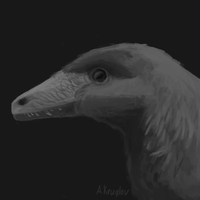Hesperornithoides
| Hesperornithoides Temporal range: Late Jurassic,
~ | |
|---|---|

| |
| Reconstructed skeleton, Wyoming Dinosaur Center | |
| Scientific classification | |
| Domain: | Eukaryota |
| Kingdom: | Animalia |
| Phylum: | Chordata |
| Clade: | Dinosauria |
| Clade: | Saurischia |
| Clade: | Theropoda |
| Family: | †Troodontidae |
| Genus: | †Hesperornithoides Hartman et al., 2019 |
| Species: | †H. miessleri
|
| Binomial name | |
| †Hesperornithoides miessleri Hartman et al., 2019
| |
Hesperornithoides (meaning "western bird form"; nicknamed "Lori") is a
Discovery
Although several Troodontid teeth were found, with the troodontid
Its discovery was announced at the 2003 annual meeting of the
Description


The length of the holotype individual was in 2019 estimated at 89 cm (35 in) long. Such a body size is rather limited for a troodontid. The specimen may represent an adult or subadult individual, due to the lack of cranial and body proportions associated with juvenile individuals. Nevertheless, either assignation would not be much different; for instance, the estimated 89 cm (35 in) would become 1 m (3.3 ft).[1]
The describing authors established some derived or
Classification

The phylogenetic analysis of 2005 placed the specimen as a close relative of
In 2019, Hesperornithoides was placed in the Troodontidae, in a relatively basal position, in a clade with Daliansaurus, Xixiasaurus and Sinusonasus, as shown in the cladogram below:[1]
| Troodontidae |
| |||||||||||||||||||||||||||||||||
Palaeobiology

Many large dinosaurs have been discovered in the Morrison Formation during the nineteenth century; Hesperornithoides proves that the full wealth of species had not yet been revealed. It lived in a relatively open well-watered landscape with low growths but few trees, or,
The layers of the Jimbo Quarry have been interpreted as a marginal lacustrine or wetland environment, representing a cyclical rise and fall in water layers.[1] Notably, the specimen preserves some keratin sheaths on the distal end of several pedal and manual unguals.[1] The relative positioning of the thoracic elements of the skeleton suggests the animal was in a resting pose and the wetland environment from which the fossil was found suggests a wetland paleoecology.[1][4]
Apart from the Avialae, most paravian groups had only few members with some flight capability. The exceptions all showed adaptations for an arboreal lifestyle, indicating flight developed multiple times when species evolved traits and behaviours useful for climbing trees or other more vertical surfaces, such as wing-assisted incline running.[1]
See also
References
- ^ PMID 31333906.
- ^ Chure, D. J. (1994). "Koparion douglassi, a new dinosaur from the Morrison Formation (Upper Jurassic) of Dinosaur National Monument; the oldest troodontid (Theropoda: Maniraptora)." Brigham Young University Geology Studies, 40: 11-15.
- ^ Foster, J. (2007). "Appendix." Jurassic West: The Dinosaurs of the Morrison Formation and Their World. Indiana University Press. pp. 327-329.
- ^ a b Trujillo, K., Chamberlain, K., & Strickland, A. (2006). Oxfordian Park: U/Pb ages from SHRIMP analysis for the Upper Jurassic Morrison Formation of southeastern Wyoming with implications for biostratigraphic correlations. Journal of Vertebrate Paleontology, 26, 1-152.
- ^ Lovelace, D.M. (2006). "An Upper Jurassic Morrison Formation fire-induced debris flow: Taphonomy and paleoenvironment of a sauropod (Sauropoda: Supersaurus vivianae) locality, east-central Wyoming." pp. 47–56 in Foster, J.R., and Lucas, S.G., eds. (2006), Paleontology and geology of the Upper Jurassic Morrison Formation. New Mexico Museum of Natural History and Science Bulletin 36.
- ^ a b Hartman, S., Lovelace, D., and Wahl, W., (2005). "Phylogenetic assessment of a maniraptoran from the Morrison Formation." Journal of Vertebrate Paleontology, 25, Supplement to No. 3, pp. 67A–68A http://www.bhbfonline.org/AboutUs/Lori.pdf Archived 2012-07-26 at the Wayback Machine
- ^ "SVP 2017 Abstracts Book". Archived from the original on 2017-08-25. Retrieved 2018-05-30.
- ^ Black, Riley. "Discovery of Raptor-Like Dinosaur Adds a New Wrinkle to the Origin of Birds". Smithsonian. Retrieved 2019-07-12.


